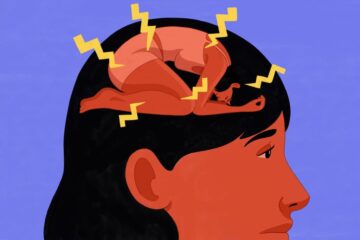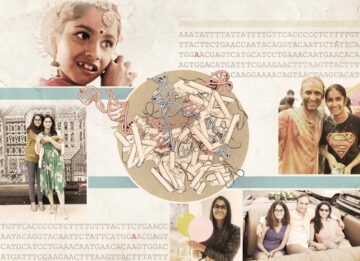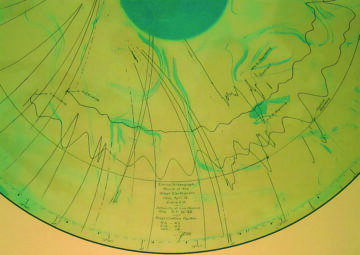Category: Archives
American cricket found a star. He’s a Silicon Valley tech worker
Pranshu Verma in The Washington Post:
A Brief History of Sexism in Medicine
Danielle Friedman in The New York Times:
 Six years ago, Dr. Elizabeth Comen, a breast cancer specialist at Memorial Sloan Kettering Hospital in Manhattan, held the hand of a patient who was hours from death. As Dr. Comen leaned in for a final goodbye, she pressed her cheek to her patient’s damp face. “Then she said it,” Dr. Comen recalled. “‘I’m so sorry for sweating on you.’” In her two decades as a physician, Dr. Comen has found that women are constantly apologizing to her: for sweating, for asking follow-up questions, for failing to detect their own cancers sooner.
Six years ago, Dr. Elizabeth Comen, a breast cancer specialist at Memorial Sloan Kettering Hospital in Manhattan, held the hand of a patient who was hours from death. As Dr. Comen leaned in for a final goodbye, she pressed her cheek to her patient’s damp face. “Then she said it,” Dr. Comen recalled. “‘I’m so sorry for sweating on you.’” In her two decades as a physician, Dr. Comen has found that women are constantly apologizing to her: for sweating, for asking follow-up questions, for failing to detect their own cancers sooner.
“Women apologize for being sick or seeking care or advocating for themselves,” she said during an interview in her office: “‘I’m so sorry, but I’m in pain. I’m so sorry, this looks disgusting.’” These experiences in the exam room are part of what drove Dr. Comen to write “All in Her Head: The Truth and Lies Early Medicine Taught Us About Women’s Bodies and Why It Matters Today.” In it, she traces the roots of women’s tendency to apologize for their ailing or unruly bodies to centuries of diminishment by the medical establishment. It’s a legacy that continues to shape the lives of women patients, she argues.
More here.
Daniel Chamovitz – Are Plants Sentient?
The Life And Death Of Hollywood
Daniel Bessner at Harper’s Magazine:
 In 2012, at the age of thirty-two, the writer Alena Smith went West to Hollywood, like many before her. She arrived to a small apartment in Silver Lake, one block from the Vista Theatre—a single-screen Spanish Colonial Revival building that had opened in 1923, four years before the advent of sound in film.
In 2012, at the age of thirty-two, the writer Alena Smith went West to Hollywood, like many before her. She arrived to a small apartment in Silver Lake, one block from the Vista Theatre—a single-screen Spanish Colonial Revival building that had opened in 1923, four years before the advent of sound in film.
Smith was looking for a job in television. She had an MFA from the Yale School of Drama, and had lived and worked as a playwright in New York City for years—two of her productions garnered positive reviews in the Times. But playwriting had begun to feel like a vanity project: to pay rent, she’d worked as a nanny, a transcriptionist, an administrative assistant, and more. There seemed to be no viable financial future in theater, nor in academia, the other world where she supposed she could make inroads.
For several years, her friends and colleagues had been absconding for Los Angeles, and were finding success. This was the second decade of prestige television: the era of Mad Men, Breaking Bad, Homeland, Girls.
more here.
Thursday Poem
Things
What happened is, we grew lonely
living among the things,
so we gave the clock a face,
the chair a back,
the table four stout legs
which will never fatigue.
We fitted our shoes with tongues
as smooth as our own
and hung tongues inside bells
so we could listen
to their emotional language,
and because we loved graceful profiles
the pitcher received a lip
the bottle a long, slender neck.
Even what was beyond us
was recast in our image;
we gave the country a heart,
the storm an eye,
the cave a mouth
so we could pass into safety.
by Lisel Mueller
from Literature and the Writing Process
Prentice Hall, 1999
Solving The Riddle Of Sigmund Freud’s Attitude To Death
George Prochnik at the TLS:
 The first time Sigmund Freud wrote of destroying his papers he was twenty-one years old. He was writing to Eduard Silberstein, an intimate friend of his youth and the sole other member of the Academia Castellana, a make-believe Spanish literary society anchored in Cervantes trivia, which served them as a secret forum for airing playful fantasies and precocious world-weariness. Freud invited Silberstein to help expunge the record of their relations by conjuring up a pleasant winter evening in which they could come together to burn their archives “in a solemn auto-da-fé”. The next occasion was eight years later, in a letter to his then fiancée Martha Bernays, during what he described as a “bad, barren month”, waiting for money from a chemist to finance further research into cocaine, doing almost nothing except browsing through Russian history and toying with two rabbits who continually nibbled turnips and messed up his floor. His only real accomplishment, he told Martha then, was to have nearly completed his intention of doing something that would dismay various unborn, unfortunate people – namely his future biographers. He’d destroyed all his notes from the past fourteen years, along with correspondence and the original manuscripts of his scientific papers. In 1907, he once again burned a huge trove of private documents. Finally, in 1938, just before escaping Nazified Vienna, he delegated to his daughter Anna the task of overseeing another bonfire of his letters, which she undertook together with his disciple Marie Bonaparte.
The first time Sigmund Freud wrote of destroying his papers he was twenty-one years old. He was writing to Eduard Silberstein, an intimate friend of his youth and the sole other member of the Academia Castellana, a make-believe Spanish literary society anchored in Cervantes trivia, which served them as a secret forum for airing playful fantasies and precocious world-weariness. Freud invited Silberstein to help expunge the record of their relations by conjuring up a pleasant winter evening in which they could come together to burn their archives “in a solemn auto-da-fé”. The next occasion was eight years later, in a letter to his then fiancée Martha Bernays, during what he described as a “bad, barren month”, waiting for money from a chemist to finance further research into cocaine, doing almost nothing except browsing through Russian history and toying with two rabbits who continually nibbled turnips and messed up his floor. His only real accomplishment, he told Martha then, was to have nearly completed his intention of doing something that would dismay various unborn, unfortunate people – namely his future biographers. He’d destroyed all his notes from the past fourteen years, along with correspondence and the original manuscripts of his scientific papers. In 1907, he once again burned a huge trove of private documents. Finally, in 1938, just before escaping Nazified Vienna, he delegated to his daughter Anna the task of overseeing another bonfire of his letters, which she undertook together with his disciple Marie Bonaparte.
more here.
Wednesday, June 12, 2024
When the Mind’s Eye Is Blind
Joshua T. Katz in The Hedgehog Review:
 When my daughter was born last year, I was fifty-three years old. I’d wanted a child so badly for so long, and her arrival may well be the most wonderful thing ever to happen to me. And yet I cannot picture her first breath, though I witnessed it from inches away. I also cannot picture her right now, as I type these words. Or my wife. Or my parents. Or my friends. Or my daughter’s nursery at home. Indeed, I have no real idea what the verb “to picture” is supposed to mean.
When my daughter was born last year, I was fifty-three years old. I’d wanted a child so badly for so long, and her arrival may well be the most wonderful thing ever to happen to me. And yet I cannot picture her first breath, though I witnessed it from inches away. I also cannot picture her right now, as I type these words. Or my wife. Or my parents. Or my friends. Or my daughter’s nursery at home. Indeed, I have no real idea what the verb “to picture” is supposed to mean.
How, after all, could I possibly picture what is not in front of me?
I say: After all. That is because I have aphantasia. I lack a mind’s eye. If you ask me to describe someone I cannot see at that moment, or something, I have no idea how to do it since my mind forms no pictures. The idea that a mind could form pictures is, to me, science fiction.
More here.
How AI is going to transform civilization over the next 5-10 years
Scott Aaronson at Shtetl-Optimized:
My friend Leopold Aschenbrenner, who I got to know and respect on OpenAI’s now-disbanded Superalignment team before he left the company under disputed circumstances, just released “Situational Awareness,” one of the most extraordinary documents I’ve ever read. With unusual clarity, concreteness, and seriousness, and with a noticeably different style than the LessWrongers with whom he shares some key beliefs, Leopold sets out his vision of how AI is going to transform civilization over the next 5-10 years. He makes a case that, even after ChatGPT and all that followed it, the world still hasn’t come close to “pricing in” what’s about to hit it. We’re still treating this as a business and technology story like personal computing or the Internet, rather than (also) a national security story like the birth of nuclear weapons, except more so. And we’re still indexing on LLMs’ current capabilities (“fine, so they can pass physics exams, but they still can’t do original physics research“), rather than looking at the difference between now and five years ago, and then trying our best to project forward an additional five years.
More here.
Israel’s Descent
Adam Shatz at the London Review of Books:
When Ariel Sharon withdrew more than eight thousand Jewish settlers from the Gaza Strip in 2005, his principal aim was to consolidate Israel’s colonisation of the West Bank, where the settler population immediately began to increase. But ‘disengagement’ had another purpose: to enable Israel’s air force to bomb Gaza at will, something they could not do when Israeli settlers lived there. The Palestinians of the West Bank have been, it seems, gruesomely lucky. They are encircled by settlers determined to steal their lands – and not at all hesitant about inflicting violence in the process – but the Jewish presence in their territory has spared them the mass bombardment and devastation to which Israel subjects the people of Gaza every few years.
The Israeli government refers to these episodes of collective punishment as ‘mowing the lawn’. In the last fifteen years, it has launched five offensives in the Strip.
More here.
Stuart Russell, “AI: What If We Succeed?”
From Géricault’s Monomanes To Balzac’s La Recherche De L’absolu
Michael Fried at nonsite:
 Put slightly differently, my point in appending a reading of “Le Colonel Chabert” to my account of Géricault was to suggest that what we find in the painter’s career is ultimately the defeat of drama and expression in the Diderotian/Davidian sense of both, which is also to say, in the terms developed in my essay, at least a partial loss of world as representable by painting. Nor does French painting following Géricault’s death undo that defeat and that loss. As I remark in “Géricault’s Romanticism,” the two major figures that dominate the scene in the second half of the 1820s and 1830s, Ingres and Delacroix, found ways of bypassing or disabling the issue of theatricality by shifting the imaginative center of their art altogether elsewhere, toward what I think of as a “stylistic” or, better, “esthetic” register (GR, 58–60). By so doing both artists secured long and productive careers, ones, however, that from my point of view remained somewhat askew to the dominant thrust or dialectic of the central current of French nineteenth-century painting.
Put slightly differently, my point in appending a reading of “Le Colonel Chabert” to my account of Géricault was to suggest that what we find in the painter’s career is ultimately the defeat of drama and expression in the Diderotian/Davidian sense of both, which is also to say, in the terms developed in my essay, at least a partial loss of world as representable by painting. Nor does French painting following Géricault’s death undo that defeat and that loss. As I remark in “Géricault’s Romanticism,” the two major figures that dominate the scene in the second half of the 1820s and 1830s, Ingres and Delacroix, found ways of bypassing or disabling the issue of theatricality by shifting the imaginative center of their art altogether elsewhere, toward what I think of as a “stylistic” or, better, “esthetic” register (GR, 58–60). By so doing both artists secured long and productive careers, ones, however, that from my point of view remained somewhat askew to the dominant thrust or dialectic of the central current of French nineteenth-century painting.
more here.
Wednesday Poem
Wait a Minute
I open my eyes in the Morning.
For a minute
I am neither here nor there.
Then in the next minute
I am here but starting
to be there.
The day has begun.
I will get up
and start to seek,
and continue starting,
so that every minute of this day
will begin with an anticipation
of the promise of the next one.
All day long and into the evening,
every minute of my waking hours,
I will not be here
because I am seeking
to be there.
I tell myself —
a pill will do it,
a walk in the fine fresh air will do it,
a Villa-Lobos prelude will do it,
a message on my answering machine will do it,
a good library book will do it,
a glass of wine at five o’clock will do it,
a good dinner will do it.
I close my eyes in the evening,
and say to myself,
with relief at the day’s ending:
a good night’s sleep will do it.
Every day is the same.
I never stop to ask:
“Do what?”
I never think to look for
what it is
that lies between the
beginning of the minute
and the end of it.
by Peggy Freydberg
from Poems from the Pond
Hybrid Nation, 2015
Are Plants Intelligent?
Rachel Riederer at The New Yorker:
 The contemporary world of botany that Schlanger explores in “The Light Eaters” is still divided over the matter of how plants sense the world and whether they can be said to communicate. But, in the past twenty years, the idea that plants communicate has gained broader acceptance. Research in recent decades has shown garden-variety lima beans protecting themselves by synthesizing and releasing chemicals to summon the predators of the insects that eat them; lab-grown pea shoots navigating mazes and responding to the sound of running water; and a chameleonic vine in the jungles of Chile mimicking the shape and color of nearby plants by a mechanism that’s not yet understood.
The contemporary world of botany that Schlanger explores in “The Light Eaters” is still divided over the matter of how plants sense the world and whether they can be said to communicate. But, in the past twenty years, the idea that plants communicate has gained broader acceptance. Research in recent decades has shown garden-variety lima beans protecting themselves by synthesizing and releasing chemicals to summon the predators of the insects that eat them; lab-grown pea shoots navigating mazes and responding to the sound of running water; and a chameleonic vine in the jungles of Chile mimicking the shape and color of nearby plants by a mechanism that’s not yet understood.
Schlanger acknowledges that some of the research yields as many questions as answers. It’s not clear how the vine gathers information about surrounding plants to perform its mimicry, or what exactly that ability says about plants’ ability to sense the world around them. And not all of the research is equally sound—the pea-shoot study, for example, performed in 2016 by the ecologist Monica Gagliano, who has written about communicating with plants while taking ayahuasca, is particularly controversial, and a replication effort was not successful. But an increasing number of scientists has begun to ask the question that animates her book: Are plants intelligent?
more here.
Hope, despair and CRISPR — the race to save one woman’s life
Heidi Ledford in Nature:
 When researcher Arkasubhra Ghosh finally met Uditi Saraf, he hoped that there was still a chance to save her. Ghosh and his collaborators were racing to design a one-off treatment that would edit the DNA in the 20-year-old woman’s brain cells and get them to stop producing toxic proteins. It was an approach that had never been tried before, with a long list of reasons for why it might not work. But the team was making swift progress. The researchers were maybe six months away from being ready to give Uditi the therapy, Ghosh told her parents over breakfast at their home outside New Delhi last June. Even so, Uditi’s mother was not satisfied. Work faster, she urged him.
When researcher Arkasubhra Ghosh finally met Uditi Saraf, he hoped that there was still a chance to save her. Ghosh and his collaborators were racing to design a one-off treatment that would edit the DNA in the 20-year-old woman’s brain cells and get them to stop producing toxic proteins. It was an approach that had never been tried before, with a long list of reasons for why it might not work. But the team was making swift progress. The researchers were maybe six months away from being ready to give Uditi the therapy, Ghosh told her parents over breakfast at their home outside New Delhi last June. Even so, Uditi’s mother was not satisfied. Work faster, she urged him.
Then, Uditi was carried to the breakfast table, and Ghosh understood her urgency. Once a gregarious and energetic child and teenager, with a quick laugh and a mischievous streak, Uditi was now unable to walk or feed herself. She had become nearly blind and deaf. Her family tried to talk to her: “These are the people who are making a therapy for you,” they said loudly. Shaken, Ghosh returned to his gene-therapy laboratory at Narayana Nethralaya Eye Hospital in Bengaluru, India, and got to work. “If you need to put up tents in the lab, then we can do so,” he told his students. “I’m not going to sleep.”
Four months later, Uditi was gone.
More here.
Toni Morrison on language, evil and ‘the white gaze’
Zoë Schlanger And Annaka Harris Discuss “The Light Eaters”
Tuesday, June 11, 2024
Don’t be terrified of Pale Fire: Nabokov’s masterpiece has a complex but huge heart
Mary Gaitskill at UnHerd:
 Pale Fire is one of the greatest books I’ve ever read. It is so great it is terrifying to write about. This is not something I would normally confess, but in this case it seems better to just come out and say it, lest the reader feel the awful stammering of suppressed terror quavering through my words without knowing what they are feeling. It is terrifying! But I want to do it anyway, because although mighty brains from all over the planet have weighed in on the subject with breath-taking and exhaustive scholarly ardour, I feel that something essential about the book remains not exactly unseen but distinctly understated.
Pale Fire is one of the greatest books I’ve ever read. It is so great it is terrifying to write about. This is not something I would normally confess, but in this case it seems better to just come out and say it, lest the reader feel the awful stammering of suppressed terror quavering through my words without knowing what they are feeling. It is terrifying! But I want to do it anyway, because although mighty brains from all over the planet have weighed in on the subject with breath-taking and exhaustive scholarly ardour, I feel that something essential about the book remains not exactly unseen but distinctly understated.
More here.
The Fault in Our Forecasts
Susan Hough at Asterisk:
 Earthquake professionals have made major strides in forecasting the long-term average rate of earthquakes in any given region. Unlike predictions, which involve meaningfully useful bounds in time, space, and magnitude, forecasts are made in terms of probabilities that an earthquake of a certain size will strike on decadal or longer timescales. For example, in 2008, seismologists predicted that there is an estimated 99.7% chance that at least one magnitude 6.7 or greater earthquake will occur in California over the next 30 years. Based on long-term odds, seismologists are known to tell the public that “it’s not a question of if, it’s a question of when” a damaging earthquake will strike.
Earthquake professionals have made major strides in forecasting the long-term average rate of earthquakes in any given region. Unlike predictions, which involve meaningfully useful bounds in time, space, and magnitude, forecasts are made in terms of probabilities that an earthquake of a certain size will strike on decadal or longer timescales. For example, in 2008, seismologists predicted that there is an estimated 99.7% chance that at least one magnitude 6.7 or greater earthquake will occur in California over the next 30 years. Based on long-term odds, seismologists are known to tell the public that “it’s not a question of if, it’s a question of when” a damaging earthquake will strike.
More here.

 Saurabh Netravalkar finds it hard to log off Slack. But a few weeks ago, the Oracle software engineer shipped his final code and set an out-of-office note on the messaging app to focus on a more personal goal: playing for the United States’ underdog cricket team at the T20 World Cup. “If there is anything urgent, my manager should be able to reach me,” he said in an interview with The Washington Post. “But I’m completely focused on the World Cup.”
Saurabh Netravalkar finds it hard to log off Slack. But a few weeks ago, the Oracle software engineer shipped his final code and set an out-of-office note on the messaging app to focus on a more personal goal: playing for the United States’ underdog cricket team at the T20 World Cup. “If there is anything urgent, my manager should be able to reach me,” he said in an interview with The Washington Post. “But I’m completely focused on the World Cup.”